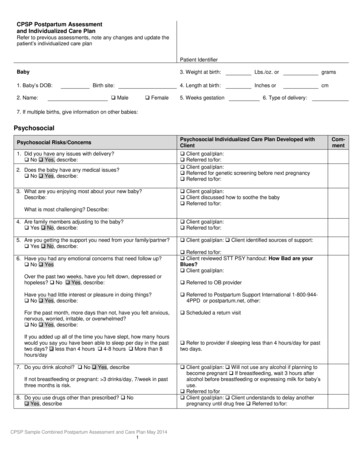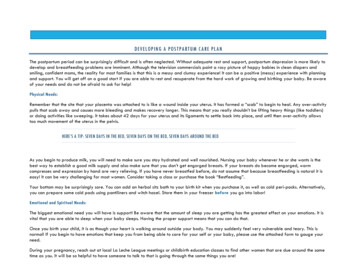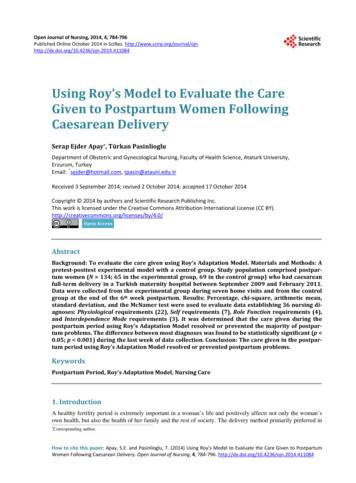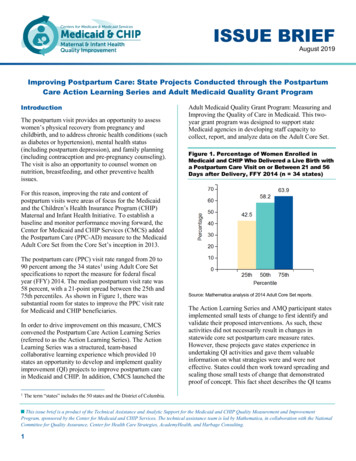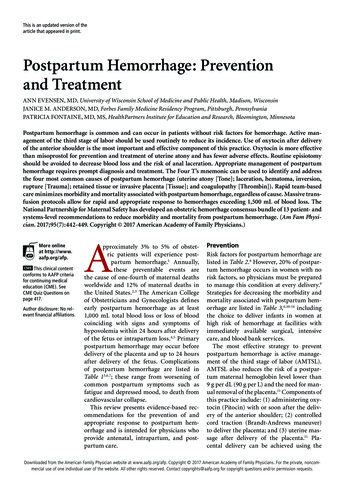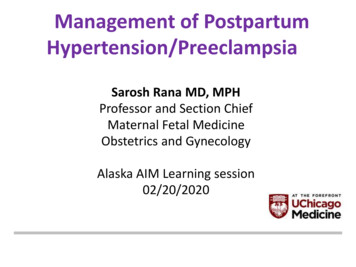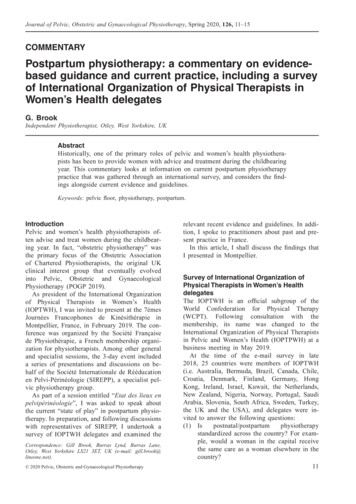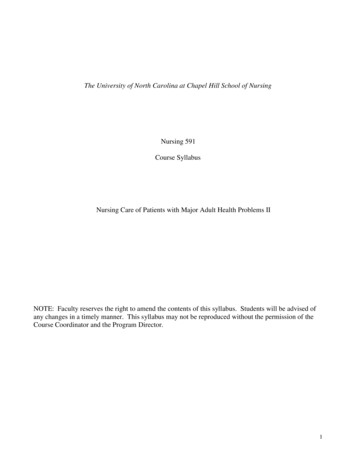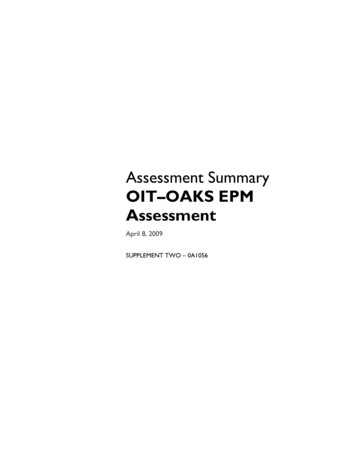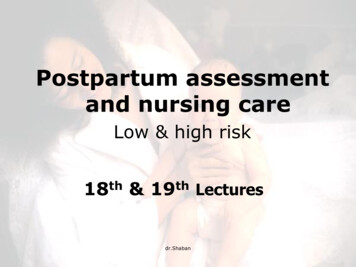
Transcription
Postpartum assessmentand nursing careLow & high risk18th & 19th Lecturesdr.Shaban
The Puerperium (Postpartum Period) Begins immediately after childbirth and lasts forapproximately six weeks, or until the body hascompleted its adjustment to a state of nonpregnancy(both physically and psychologically).Maternal changes period:1. Retrogressive: involution of the uterus and vagina2. Progressive:-Production of milk and lactation-Restoration of normal menstrual cycle-Beginning of parenting dr.Shaban
Newborn Infants need Acceptance of Sex, Appearance, Size Recognition by the country (vital registrationsystemMother’s need Information/counseling on What happens in their bodies including signs ofpossible problems Self care/hygiene and healing Nutrition Sexual Life Care of the baby and breastfeedingdr.Shaban Contraception
Goal of postpartum careAssist and support the woman’s recovery,assess and identify deviations from thenorm & educate the mother about herown self care and infant care During the fourth stage of labor thewoman is closely observed forhemorrhage and hypovolemic shock After the initial dangers of hemorrhageand shock have passed the primarypostpartum danger is infection dr.Shaban4
Psychological Changes of the PostpartalPeriod1.The taking-in phase : during 2- to 3-dayperiod, the woman is largely passive. Womanusually wants to talk about her pregnancy(Reflection), especially about her labor andbirth. She prefers having a nurse makedecisions for her.Women's need at this timeEncouraging her to talk about the birth helps her integrate itinto her life experiences, Not receptive to teaching at thistime2.During the taking-in phase, she rests to regain her physicalstrength and to calm and contain her swirling thoughts.dr.ShabanAnticipatory stage: looks to role models1.
2. The taking-hold phaseFrom 3-10 day. The mother assumes moreresponsibility and is more independent aboutherself and her infant once her basic needs havebeen met. Ready to receive health teachingand info.Women's need at this time Give a woman brief demonstrations of baby careand then allow her to care for her child herself Women who give birth without any anesthesia mayreach this second phase in a matter of hours afterbirth. (also Rooming-In ) Formal stage: influenced by the guidance ofdr.Shabanothers
3. The letting-go phase The mother begins to view the infant as aseparate person. Some mothers have adifficult time with this concept andpsychological problems can occur if this isnot resolve. Roles may becomedisorganized relating to infant rearing,homemaking, and careerInformal ( Personal) stage : womanstarts to make her own decisions anddone what she is comfortable with.dr.Shaban
Maternal Concerns and Feelings inthe Postpartal Period Abandonment (Only hours before, they werethe center of attention. Now, suddenly, the babyseems to be everyone's chief interest.Disappointment: It can be difficult for parentsto feel positive immediately about a child whodoes not meet their expectations.Postpartal Blues (The syndrome is evidencedby tearfulness, mood sweening, anorexia, andsleep disturbance. Reassure a woman and hersupport person that sudden crying episodes arenormal).It is also important to give the woman achance to verbalize her feelingsdr.Shaban
Physiologic ChangesThe Circulatory System 1. Cardiac output is 60% to 80% higher thanprelabor levels and remains elevated for at least48 hours after delivery as a result to:The pressure of the pregnant uterus iseliminated, lead to increased blood return to thevena cava. The blood that supplied theuteroplacental vascular bed goes back into thesystemic circulation. The rapid reduction in thesize of the uterus causes a decrease in systemicvascular resistance.The blood volume has returned to its normalprepregnancy level by the first or second weekafter birth.Usual blood loss with a vaginal birth is 300 to 500dr.ShabanmL. With a cesarean birth, it is 500 to 1,000 mL.
Vital Sign Changes Temperature:First 24 hours: slight increase related to dehydration during laborAfter 24 hours a rise of above 38 degrees is febrile. A postpartum infection issuspected.On the 3rd to 4th day: a rise for a period of hours because of breasts filling withmilk. If it lasts more it is suspicious of postpartum infection.Pulse:Usually decreases to the end of Ist week. Tachycardia over 100 indicatehypovolemic shock, fever, anxiety, pain, excitement, or physical exertion ormedication Blood pressure: Remain normal the first 24 hours after delivery. Orthostatic hypotension iscaused fainting on the client’s first ambulation, it is important to evaluate herstability. Respiratory rate usually will remain normal
The Hormonal Changes &Menstrual Cycle: Pregnancy hormones begin to decrease as soon asthe placenta is no longer present.By week1, progestrone are at pre pregnancy levels.Follicle-stimulating hormone (FSH) remains low forabout 12 days and then begins to rise as a newmenstrual cycle is initiated.A woman who is not breast -feeding can expect hermenstrual flow to return in 6 to 10 weeks afterbirth.If she is breast -feeding, menstrual flow may notreturn for 3 or 4 months (lactational amenorrhea)or, in some women, for the entire lactation period.dr.Shaban
The Integumentary System After birth, the stretch marks on the woman'sabdomen (striae gravidarum) still appearreddened and may be even more prominent thanduring pregnancy, when they were tightlystretched.Excessive pigment on the face and neck(chloasma) and on the abdomen ( linea nigra)will become barely detectable in 6Weeks' time.If diastasis recti (over stretching and separationof the abdominal musculature) is present, thearea will appear slightly indented.dr.Shaban
The Urinary System During pregnancy, as much as 2,000 to 3,000 mLexcess fluid accumulate in the body. An extensivediuresis begins to take place almost immediately afterbirth to rid the body of this fluid.Pressure during vaginal birth may leave the bladderwith a transient loss of tone that, together with theedema surrounding the urethra, decreases a woman'sability to sense when she has to void.Diaphoresis (excessive sweating) is another way bywhich the body rids itself of excess f luid. This isnoticeable in women soon after birth.dr.Shaban
The Gastrointestinal System Digestion and absorption begin to be active again soon after birth. Almost immediately, the woman feels hungry and thirsty becauseof the long period of restricted fluid during labor and the beginningdiaphoresis. Hemorrhoids (distended rectal veins) that have been pushed out ofthe rectum due to the effort of pushing often are present. Bowel sounds are active, but passage of stool through the bowelmay be slow because of the still-present effect of relaxin on thebowel. Bowel evacuation may be difficult due to the pain ofdr.Shabanepisiotomy sutures or hemorrhoids.
POSTPARTUM NURSINGASSESSMENTDone twice a day until discharge. The nurse must explain what is happening and whatthe mother can expect. At all times,The nurse maintains the mother’s privacy.Hand washing precedes any assessment & usenonsterile gloves and universal precautions toprevent contact with blood and other body fluids,including breast milk.Assessment—”Bubble”B—Breasts U—Uterus B—Bladder B—BowelL—Lochia E—Epistomy/Extremitiesdr.Shaban
Assisting with BreastfeedingImmediately following delivery of the baby, the newmother’s breasts produce colostrum, a thin yellowish fluidthat contains extra calories and protein, as well asimportant antibodiesColostrum is usually secreted for 2 to 3 days after birth andis then replaced by the mother’s breast milkBreastfeeding requires the mother to take in extra caloriesand fluidsThe woman’s breasts may become swollen and painfulwhen the milk comes inFrequent nursing of the infant will help to ease thediscomfort, which usually only lasts for a couple of daysThe appearance of a painful lump, reddened areas, or anelevated temperature could indicate a breast infection andshould be reported to the nurseimmediately16dr.Shaban
Assisting with BreastfeedingHelp her to first wash her hands and then gently clean the nippleof the breast with warm waterNext, hand the mother the babyHave the mother stroke the baby’s cheek with her nipple tostimulate the baby’s rooting reflexThe mother needs to place all of the nipple and part of the areolainto the baby’s mouthShe may need to use her finger to help keep her breast fromblocking the baby’s nose while he nursesAs the baby sucks on the breast, the mother may experiencecramping pains in her lower abdomenAfter the baby has finished feeding from the first breast, themother inserts her finger gently into his mouth to break thesuction before removing him from the breastAfter burping the baby, the process is repeated with the otherbreast17dr.Shaban
Factors contributing to the successof breastfeedingThe mother’s willingness to breastfeed. Manymothers do not feel comfortable exposingtheir breasts. Also, mothers may believe thatbreastfeeding interferes with their home andwork routines, or may have had a negativeexperience in the past with lack of support Suppressing LactationNonpharmacologic suppression, which isknown as mechanical suppression (breast binder for at least 7 hours after delivery. Avoid anybreast stimulation). dr.Shaban
Nursing Diagnosis Related to Breasts andBreastfeeding Pain r/t improper positioning, engorgedbreastsIneffective breastfeeding r/t maternaldiscomfort, improper infant positioningKnowledge deficit r/t normal physiologicchanges, breastfeedingInfection r/t improper breastfeedingtechniques, improper breast caredr.Shaban
Uterus– Involution —”Bubble” Def: reduction in the size of the uterus and itsreturn to a condition similar to its prepregnant stateThe fundus of the uterus palpated at the halfwaybetween the umbilicus and the symphysis pubis,within a few minutes after birth.One hour later, it will have risen to the level of theumbilicus, where it remains for approximately thenext 24 hours.Then, it decreases one fingerbreadth (1 cm) per dayBy the ninth or tenth day, the uterus withdrawn intothe pelvis and can't be detected by abdominalpalpationdr.Shaban
To determine fundal position andheight Ask the mother empty her bladder.Don nonsterile glovesAsk the mother to flex her legs and relaxthe abdominal muscles. This position willcause less discomfort during theprocedure.To avoid inversion of the atonic uterus,place one hand above the symphysispubis and gently support the lowersegment of the uterus. Using the side ofthe other hand, locate the uterus and cupthe hand over the fundus. Keeping thefingers flat and applying firm pressuredownward toward the vagina, gentlymassage.If the mother is anxious, give ananalgesic 15 to 20 minutes before theassessment or encourage the mother todr.Shabanuse her labor breathing techniques.21
Assessing the uterine fundus The nurse should determineLocation, firmness/consistency of the uterinefundusDetermination of the uterinefundal position and heightHeight/location is measured infingerbreaths, above below or atthe umbilicus. e.g @U, or U-2Consistency is documented asfirm, soft or boggyIf the uterus is “boggy” it shouldbe massageddr.Shaban
After pains: In some women, contraction of the uterus after birth causesintermittent cramping similar to that accompanying a menstrualperiod. They tend to be noticed most by multiparas rather thanprimiparas and by women who have given birth to large babies orhad an over distended uterus for any other reason. In these situations, the uterus must contract more forcefully toregain its prepregnancy size and has difficulty maintaining a steadycontracted state. These sensations are noticed most intensely with breast- feeding,when the infant's sucking causes a release of oxytocin from theposterior pituitary, increasing the strength of the contractions.dr.Shaban
Nursing Interventions in caseof After pain Lying in a prone position with a small pillow under the abdomenwill help decrease the discomfort. Encourage the mother to empty her bladder before shebreastfeeds. An empty bladder will allow the uterus to contractmore efficiently and decreases the discomfort Analgesia :The nurse evaluates the effectiveness of the analgesiaevery 15 minutes until acceptable pain relief is achieved.Therefore, if the client has not achieved appropriate pain reliefwithin 30 minutes, initiate nonpharmacologic pain measures thathave not already been used such as distraction, heat, and a cold ordr.Shabanwarm shower
Postpartum Cesarean Incision site redness swelling, discharge. Intact?Abdomen soft, distended? Bowel sounds heard all4 quadrantsFlatus?Lochia is less amount than in normal spontaneousvaginal delivery (NSVD) because uterus is wipedwith sponges during c/section.If lochia indicates excessive bleeding, combinepalpation and pain management measures.Auscultate breath soundsFluid intake and outputPain?dr.Shaban
Bladder-- Bubble Diuresis begins to take place almost immediatelyafter birth to rid the body fluid.Pressure during vaginal birth may leave thebladder with a transient loss of tone that,together with the edema surrounding the urethra,decreases a woman's ability to sense when shehas to void.Assessment reveals a dull sound heard onpercussionDiaphoresis (excessive sweating) is another wayby which the body rids itself of excess fluid. Thisis noticeable in women soon after birth.dr.Shaban
Nursing Interventions in UrinaryElimination Problem Insure that there is adequate fluid intakeGive an analgesia 15 to 20 minutes before she usesthe bathroom.When the mother is sitting on the toilet, run warmwater over her perineal area. This sensory input maystimulate voiding.Turn on the tap water to provide the sound ofrunning water.Provide the mother with privacy and do not rush her.If the mother’s bladder is distended and she isunable to void a
Goal of postpartum care . and then allow her to care for her child herself Women who give birth without any anesthesia may reach this second phase in a matter of hours after birth. (also Rooming-In) Formal stage: influenced by the guidance of others dr.Shaban . 3. The letting-go phase The mother begins to view the infant as a separate person. Some mothers have a difficult time with this .
